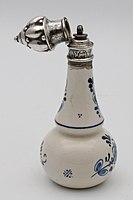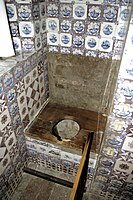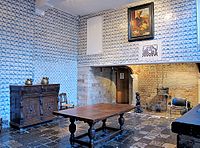Delftware


Delftware or Delft pottery, also known as Delft Blue[1] (Dutch: Delfts blauw) or as delf,[2] is a general term now used for Dutch tin-glazed earthenware, a form of faience. Most of it is blue and white pottery, and the city of Delft in the Netherlands was the major centre of production, but the term covers wares with other colours, and made elsewhere. It is also used for similar pottery, English delftware.
Delftware is one of the types of
Delftware includes pottery objects of all descriptions - such as plates, vases, figurines and other ornamental forms and tiles. The style originated around 1600, and the most highly regarded period of production is about 1640–1740, but Delftware continues to be produced. In the 17th and 18th centuries the manufacture of Delftware was a major industry, with product exported all over Europe.
History
The earliest tin-glazed pottery in the Netherlands was made in Antwerp where the Italian potter Guido da Savino settled in 1500,[3] and in the 16th century Italian maiolica was the main influence on decorative styles.[4] The manufacture of painted pottery spread from Antwerp to the northern Netherlands, in particular because of the sack of Antwerp by the Spanish troops in 1576 (the Spanish Fury). Production developed in Middelburg and Haarlem in the 1570s and in Amsterdam in the 1580s.[5] Much of the finer work was produced in Delft, but simple everyday tin-glazed pottery was made in places such as Gouda, Rotterdam, Haarlem, Amsterdam and Dordrecht.[6]
The main period of tin-glaze pottery in the Netherlands was 1640–1740. From about 1640 Delft potters began using personal monograms and distinctive factory marks. The
The use of marl, a type of clay rich in calcium compounds, allowed the Dutch potters to refine their technique and to make finer items. The usual clay body of Delftware was a blend of three clays, one local, one from Tournai and one from the Rhineland.[8]
From about 1615, the potters began to coat their pots completely in white tin glaze instead of covering only the painting surface and coating the rest with clear ceramic glaze. They then began to cover the tin-glaze with clear glaze, which gave depth to the fired surface and smoothness to cobalt blues, ultimately creating a good resemblance to porcelain.[9]

During the Dutch Golden Age, the Dutch East India Company had a lively trade with the East and imported millions of pieces of Chinese porcelain in the early 17th century.[10] The Chinese workmanship and attention to detail impressed many. Only the richest could afford the early imports. Dutch potters did not immediately imitate Chinese porcelain; they began to do so after the death of the Wanli Emperor in 1620, when the supply to Europe was interrupted.[9] "Potters now saw an opportunity to produce a cheap alternative for Chinese porcelain. After much experimenting they managed to make a thin type of earthenware which was covered with a white tin glaze. Although made of low-fired earthenware, it resembled porcelain amazingly well."[11]
Delftware inspired by Chinese originals persisted from about 1630 to the mid-18th century alongside European patterns. Around 1700 several factories were using enamel colours and gilding over the tin-glaze, requiring a third kiln firing at a lower temperature. Later, after Japanese Imari ware had become popular in the late 1600s and early 1700s (when it too tried to fill the gap of the Chinese shortage), Delft began making their own 'Imari ware' copying the classic 'flower vase on a terrace surrounded by three panels with cranes and pine design'. Oriental styles in Delftware remained popular into the early 1700s but then declined when Chinese porcelain became available again.[12]
Delftware ranged from simple household items – plain white
Some regard Delftware from about 1750 onwards as artistically inferior. Caiger-Smith says that most of the later wares "were painted with clever, ephemeral decoration. Little trace of feeling or originality remained to be lamented when, at the end of the eighteenth century, the Delftware potteries began to go out of business."
Today, Delfts Blauw (Delft Blue) is the brand name hand painted on the bottom of ceramic pieces identifying them as authentic and collectible. Although most Delft Blue borrows from the tin-glaze tradition, it is nearly all decorated in underglaze blue on a white clay body and very little uses tin glaze, a more expensive product. The
Delft Blue pottery formed the basis of one of British Airways' ethnic tailfins. The design, Delftblue Daybreak, was applied to 17 aircraft.
Object gallery
-
Delftware inPushkin Art Museum, Russia
-
Two flower vases, early 18th century, Delft
-
Tulip vase, Museum Boijmans Van Beuningen
-
Charger with Shiba Onko Design, c. 1730, Delft
-
AnGeelvinck-Hinlopen Huis
-
Boar's Head Tureen and Stand, c. 1750
-
A famille rose plate, around 1770, Musée des Arts Décoratifs, Paris
-
A ceramics workshop in Delftse Pauw
-
Painting of color Delft pottery
-
Schoonhoven silver topped scent bottle
Tile gallery
-
Museum ofFriesland, Leeuwarden, Netherlands
-
Biblical tiles, Museum of Gdańsk, Poland
-
Toilet of Rosenborg Castle, Copenhagen
-
Farmhouse interior, Hoogland, near Utrecht
-
Kitchen of the Hospice Comtesse, Lille
-
Swimming pool of Nymphenburg Palace, Munich
-
Kitchen of the Amalienburg, Nymphenburg Palace
-
Reconstitution of theVersailles
-
Braemar Castle, Cow & Milkmaid tile by fireplace.
-
Braemar Castle, Horse & Rider tile by fireplace.
-
Braemar Castle, Windmill tile by fireplace.
See also
- English Delftware
- Gallery Terra Delft, modern ceramic art
- Maiolica
- KLM (section Delft Blue houses)
- Koninklijke Porceleyne Fles
- Kraak porcelain
- Tulip vase, type of Delftware faience
References
- ^ Delft Blue, Holland.com
- ^
Rees, Abraham (1819) [1808]. "DELF". The Cyclopaedia; Or, Universal Dictionary of Arts, Sciences and Literature: In Thirty-nine Volumes. Vol. 11. London: Longman, Hurst, Rees, Orme & Brown. p. 74. Retrieved 9 November 2022.
DELF, or Delft-ware , Fr. Fayence , a kind of pottery of baked earth , covered with an enamel , or white glazing , which gives it the appearance and neatness of porcelain .
- ^ La Céramique anversoise de la Renaissance, de Venise à Delft, Claire Dumortier, Anthèse, Paris, 1997
- ^ Savage, 157
- ISBN 0-571-09349-3, p. 127
- ^ Caiger-Smith, p. 131
- ^ Caiger-Smith pp. 130–131
- ^ Caiger-Smith, p. 130
- ^ a b Caiger-Smith, p. 129
- ^ Volker, T. Porcelain and the Dutch East India Company, 1602–1683, Leiden, 1955) p. 22.
- ^ Christiaan Jörg, "Oriental Export Porcelain and Delftware in the Groningen Museum" in Ceramics Crossed Overseas: Jingdezhen, Imari and Delft from the collection of the Groningen Museum. An exhibition catalogue in collaboration with the Groninger Museum, Kyushu Ceramic Museum, Japan Airlines, 1999-2000, p. 10.
- ^ Christiaan Jörg, pp. 10-11.
- ^ Caiger-Smith, p. 136.
- ^ Caiger-Smith, p. 137 n. 21
- ^ Caiger-Smith, p. 140
- ^ tichelaar.nl
- ^ Klei/Glas/Keram. 13, No.4, 1992. Pg.103-106
- ^ "Koninklijke Tichelaar Makkum". Tichelaar.nl. Retrieved 2012-02-22.
Bibliography
- Alan Caiger-Smith, Tin-Glaze Pottery in Europe and the Islamic World: The Tradition of 1000 Years in Maiolica, Faience and Delftware, Faber and Faber, 1973 ISBN 0-571-09349-3
- Jan Pluis, The Dutch Tile, Designs and Names 1570–1930, Nederlands Tegelmuseum – Friends of the Museum of Otterlo Tiles, Primavera Pers, Leiden 1997
- Savage, George, Pottery Through the Ages, Penguin, 1959
External links
- Delftware techniques
- Illustrated history of the Dutch tile
- History of Delftware
- Preservation of the Delft tile























